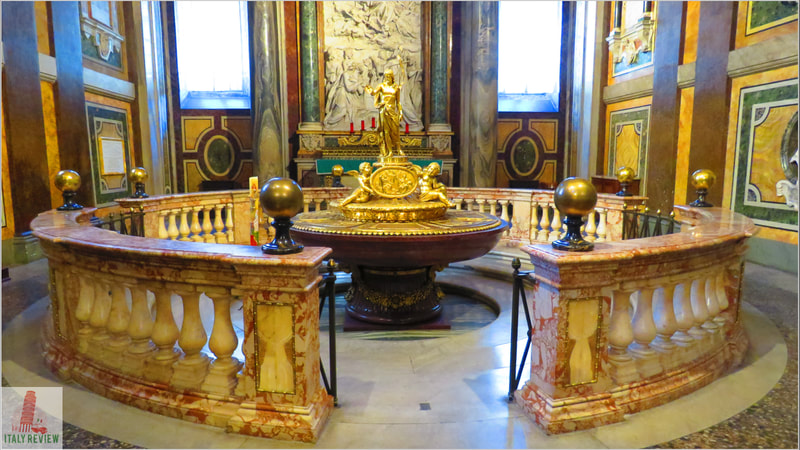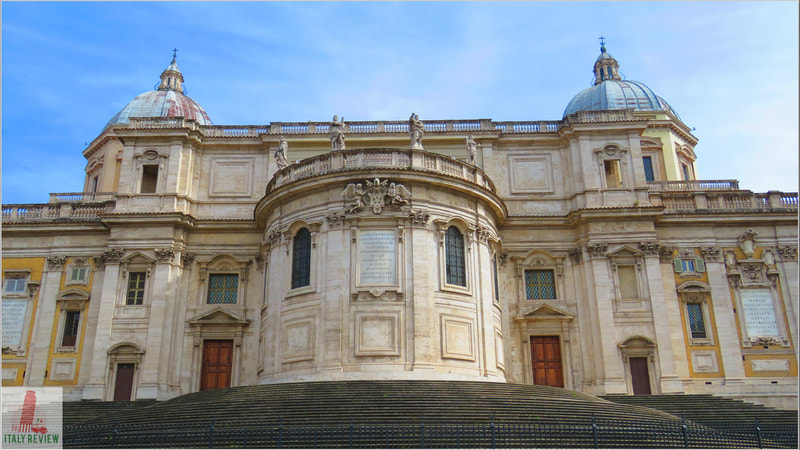Basilica di Santa Maria Maggiore
|
By Dion Protani
|
Latest update: 23 January 2024
|
|
The Basilica di Santa Maria Maggiore is one of the most important churches in Rome. It's one of just four churches classified as a major basilica, along with Saint Peter's Basilica, the Archbasilica of Saint John Lateran and the Basilica of Saint Paul Outside the Walls.
The church was originally established in the 5th century but has been greatly refurbished and added to in the intervening years. |
Related links
Profile
The Basilica di Santa Maria Maggiore, also known as the Basilica of St. Mary Major, is one of the four major basilicas in Rome and one of the most important churches in the Roman Catholic tradition. It is renowned for its ancient origins, stunning architecture, and rich artistic and religious significance.
The Basilica di Santa Maria Maggiore is an impressive structure with a mix of architectural styles, including Romanesque, Baroque, and Renaissance. The facade is adorned with intricate mosaics and statues, showcasing the beauty of its different eras of construction.
Inside the basilica, visitors can marvel at the opulence of the interior, which features beautiful marble, frescoes, and numerous chapels. The main altar is adorned with a stunning gold canopy, and the coffered ceiling, dating back to the 16th century, is a masterpiece of craftsmanship.
One of the most notable features of Santa Maria Maggiore is its magnificent mosaics. The basilica boasts some of the oldest and finest mosaics in Rome, depicting scenes from the life of Christ and the Virgin Mary.
The Basilica di Santa Maria Maggiore is an impressive structure with a mix of architectural styles, including Romanesque, Baroque, and Renaissance. The facade is adorned with intricate mosaics and statues, showcasing the beauty of its different eras of construction.
Inside the basilica, visitors can marvel at the opulence of the interior, which features beautiful marble, frescoes, and numerous chapels. The main altar is adorned with a stunning gold canopy, and the coffered ceiling, dating back to the 16th century, is a masterpiece of craftsmanship.
One of the most notable features of Santa Maria Maggiore is its magnificent mosaics. The basilica boasts some of the oldest and finest mosaics in Rome, depicting scenes from the life of Christ and the Virgin Mary.
History
According to tradition, the Basilica di Santa Maria Maggiore was founded in the 4th century after the Virgin Mary appeared in a dream to Pope Liberius and a wealthy Roman patrician named John.
The Virgin Mary instructed them to build a church on the Esquiline Hill, and the outline of the church was miraculously marked by a snowfall on the hill on August 5, 358 AD. As a result, the basilica is also known as "Our Lady of the Snows."
The basilica has undergone various renovations and additions over the centuries, with contributions from different popes and rulers. Despite these changes, the original basilica's core structure remains, making it one of the oldest churches in Rome.
The Virgin Mary instructed them to build a church on the Esquiline Hill, and the outline of the church was miraculously marked by a snowfall on the hill on August 5, 358 AD. As a result, the basilica is also known as "Our Lady of the Snows."
The basilica has undergone various renovations and additions over the centuries, with contributions from different popes and rulers. Despite these changes, the original basilica's core structure remains, making it one of the oldest churches in Rome.
Key features
- Opening Hours: The basilica is generally open to visitors during specific hours. It's recommended to check the specific opening times before planning your visit.
- Entrance Fee: There is no entrance fee to access the basilica. However, donations are appreciated for its upkeep and conservation.
- Dress Code: As with most religious sites in Italy, modest dress is required. Visitors should avoid wearing sleeveless tops, shorts, or skirts above the knee.
- Guided Tours: Guided tours are available for those who want to learn more about the basilica's history, art, and religious significance.
- Events: The basilica occasionally hosts liturgical events, concerts, and special religious celebrations, which can provide a unique and enriching experience for visitors.
Basilica di Santa Maria Maggiore - Roma
|
City: Rome
Province: Metropolitan City of Rome Region: Lazio Groundbreaking: 432 AD Architectural style: Classic Roman, Romanesque, Baroque Nearest Metro: Cavour - Line B - 550 m - 8 minute walk Fly to: Rome Fiumicino Airport - 30 minutes by car (29 km) Close by: Rome Termini Train Station, Colosseum, Roman Forum Recommended accommodation: Hotel Artemide |
UNESCO World Heritage Site
Historic Centre of Rome, the Properties of the Holy See in the City Enjoying Extraterritorial Rights and San Paolo Fuori le Mura
Year: 1980
Historic Centre of Rome, the Properties of the Holy See in the City Enjoying Extraterritorial Rights and San Paolo Fuori le Mura
Year: 1980























